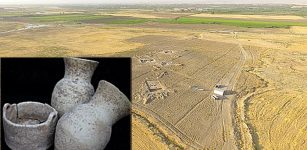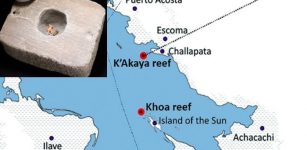Magnificent Hattusa: Capital Of The Hittite Empire
A. Sutherland - AncientPages.com - Hattusa was the capital of the kingdom of the Hittites in the late Bronze Age. In the 2nd millennium BC, the kingdom stretched from the Aegean across Anatolia, Turkey, northern Syria, and to the Euphrates River.
In ancient times, it was a great city, and even today, its magnificent ruins attest to the greatness of this place. The population of the old capital is estimated to have been 50,000 at its most.
 Hattusa is one of Turkey’s great ruins of the capital of the Hittite Empire.
Hattusa is one of Turkey’s great ruins of the capital of the Hittite Empire.
Hattusa has a rich history with its six-kilometre walls surrounding the ancient city, its monumental gates, the 71-meter-long underground passage, and 31 temples unearthed so far. The Lion Gate, the King Gate, and the Yazılıkaya Open Air Temple are some of the impressive landmarks.
The first settling around Hattusa took place in the 6th millennium BC during the Chalcolithic period, when small, widely scattered hamlets appeared, most particularly on mountain slopes and rocky outcroppings. Late in the 3rd millennium BC, towards the end of the Early Bronze Age, a Hattian settlement developed, marking the beginning of continuous occupation at the site.
 Hattusha - The King Gate Image credit: Wikipedia
Hattusha - The King Gate Image credit: Wikipedia
The Hittites ruled the central Anatolian kingdom of Hatti from c. 1900 - to 800 BCE. They formed the earliest known Anatolian civilization and employed an advanced system of government based on an established legal system. Their military force was well trained, well equipped, and employed chariots that were the lightest and fastest of their time.
Hattusa consists of two sites: the Lower City and the Upper City. The Hittites built their capital on a site that could be well defended.
The ruins of the upper city’s fortification reveal that the city was surrounded by a double wall (forming a perimeter of roughly 8 km) with more than a hundred towers and, as far as is known today, five gateways: two in the west, Lion’s Gate in the south-west, the King’s Gate in the south-east and a procession gate, the Sphinx Gate in the south of the city.
 Hattusa - The Lion Gate in the south-west. Image credit: Bernard Gagnon - CC BY-SA 2.5
Hattusa - The Lion Gate in the south-west. Image credit: Bernard Gagnon - CC BY-SA 2.5
To the north, beyond the walls, there was a necropolis cut into the rock at Osmankayasi and the great sanctuary of Yazilikaya, whose walls decorated with bas-reliefs are the undisputed masterpiece of Hittite art.
Hattusa - The Sphinx Gate. Adobe Stock - marista
The best-preserved ruin of a Hittite Temple from the 13th century B.C., known as the Great Temple, is located in the Lower City. The Great Temple was dedicated to the god of storms and the goddess of the Sun, Arinna, and surrounded by an array of buildings, including stores.
Thousands of cuneiform tablets were found in this area. One of the most important discoveries has been the cuneiform royal archives of clay tablets, consisting of official correspondence and contracts, legal codes, procedures for cult ceremonies, oracular prophecies, and literature of the ancient Near East.
One particularly important tablet, currently on display at the Istanbul Archaeology Museum, details the terms of a peace settlement reached years after the Battle of Kadesh between the Hittites and the Egyptians under Ramesses II in 1259 or 1258 BC.
Twelve Hittite gods of the Underworld in the nearby Yazılıkaya, a sanctuary of Hattusa. Image credit: WikipediaOther temples of similar date and shape, albeit generally smaller, are situated in the Upper City, which mostly consisted of a temple city for the gods and goddesses of the Hittite and Hurrian pantheon. The remains of a densely inhabited city district were unearthed in the Lower City, where their foundations and arrangement can still be seen in the area north of the Great Temple.
The site, discovered in 1834, was not comprehensively excavated until 1906. The site has been on the World Heritage List since 1986.
Written by – A. Sutherland AncientPages.com Staff Writer
Copyright © AncientPages.com All rights reserved. This material may not be published, broadcast, rewritten or redistributed in whole or part without the express written permission of AncientPages.com
Expand for referencesMore From Ancient Pages
-
 Why Is A ‘Piggy Bank’ Shaped Like A Pig?
Ancient History Facts | Jun 11, 2018
Why Is A ‘Piggy Bank’ Shaped Like A Pig?
Ancient History Facts | Jun 11, 2018 -
 Mesopotamian People Liked To Drink Beer Using Variety Of Drinking Vessels
Archaeology | Jun 28, 2018
Mesopotamian People Liked To Drink Beer Using Variety Of Drinking Vessels
Archaeology | Jun 28, 2018 -
 Why Have The Leibniz Keks 52 Teeth And Are Named After Philosopher Gottfried Wilhelm Leibniz?
Ancient History Facts | Mar 12, 2021
Why Have The Leibniz Keks 52 Teeth And Are Named After Philosopher Gottfried Wilhelm Leibniz?
Ancient History Facts | Mar 12, 2021 -
 Unique Discovery – 2,000-Year-Old Roman Coins Found On Gotska Sandön In Sweden
Archaeology | Apr 13, 2023
Unique Discovery – 2,000-Year-Old Roman Coins Found On Gotska Sandön In Sweden
Archaeology | Apr 13, 2023 -
 DNA Reveals – One Of Sunken Warship Vasa’s Crewmen Was A Woman
Archaeology | Apr 4, 2023
DNA Reveals – One Of Sunken Warship Vasa’s Crewmen Was A Woman
Archaeology | Apr 4, 2023 -
 Stone Box With Ancient Shell Llama Offering Found In Lake Titicaca
Archaeology | Aug 4, 2020
Stone Box With Ancient Shell Llama Offering Found In Lake Titicaca
Archaeology | Aug 4, 2020 -
 Gold Treasures Of Ancient King Discovered In North America Create Historical Problems
Ancient Mysteries | Jun 29, 2018
Gold Treasures Of Ancient King Discovered In North America Create Historical Problems
Ancient Mysteries | Jun 29, 2018 -
 Ancient Mystery Of The Man Mound And The Giant With Horns In Wisconsin
Featured Stories | Mar 1, 2021
Ancient Mystery Of The Man Mound And The Giant With Horns In Wisconsin
Featured Stories | Mar 1, 2021 -
 518-Million-Year-Old-Rocks Suggest Animal And Human Life May Have First Emerged In China – Scientists Say
News | Apr 19, 2022
518-Million-Year-Old-Rocks Suggest Animal And Human Life May Have First Emerged In China – Scientists Say
News | Apr 19, 2022 -
 Brown Hares And Chickens Were Seen As Gods Not Food In Iron Age Britain
Archaeology | Apr 12, 2020
Brown Hares And Chickens Were Seen As Gods Not Food In Iron Age Britain
Archaeology | Apr 12, 2020 -
 On This Day In History: Battle Of Lihula Between Swedish And Estonian Armies Was Fought – On August 8, 1220
News | Aug 8, 2016
On This Day In History: Battle Of Lihula Between Swedish And Estonian Armies Was Fought – On August 8, 1220
News | Aug 8, 2016 -
 Mystery Of The Real Sword: How Did A Meter Long Sword End Up In Solid Rock?
Artifacts | Apr 15, 2019
Mystery Of The Real Sword: How Did A Meter Long Sword End Up In Solid Rock?
Artifacts | Apr 15, 2019 -
 Attila The Hun: The Destroyer Of Rome Among Most Fearsome Enemies The Empire Ever Faced
Featured Stories | Jun 24, 2019
Attila The Hun: The Destroyer Of Rome Among Most Fearsome Enemies The Empire Ever Faced
Featured Stories | Jun 24, 2019 -
 Wendigo: Cannibalistic Shapeshifter In Mythology Of Indians Of North America And Canada
Featured Stories | Sep 3, 2016
Wendigo: Cannibalistic Shapeshifter In Mythology Of Indians Of North America And Canada
Featured Stories | Sep 3, 2016 -
 Ancient Copy Of Jesus’ Secret Teachings To His Brother James Discovered – First Apocalypse And Future Events Described
Artifacts | Dec 2, 2017
Ancient Copy Of Jesus’ Secret Teachings To His Brother James Discovered – First Apocalypse And Future Events Described
Artifacts | Dec 2, 2017 -
 Peru’s Wari Culture And Their Ancient ‘Amunas’ Will Help Peru’s Water
Ancient Technology | Apr 13, 2015
Peru’s Wari Culture And Their Ancient ‘Amunas’ Will Help Peru’s Water
Ancient Technology | Apr 13, 2015 -
 Ancient Graves That Date Back To Pre-Vijaya Era Discovered In Sri Lanka
Archaeology | Oct 21, 2015
Ancient Graves That Date Back To Pre-Vijaya Era Discovered In Sri Lanka
Archaeology | Oct 21, 2015 -
 Earliest Baltic Amber In Western Europe Found On The Iberian Peninsula 5,000 Years Ago
Archaeology | Oct 21, 2023
Earliest Baltic Amber In Western Europe Found On The Iberian Peninsula 5,000 Years Ago
Archaeology | Oct 21, 2023 -
 On This Day In History: Fire Of Skopje Started Intentionally – On Oct 26, 1689
News | Oct 26, 2016
On This Day In History: Fire Of Skopje Started Intentionally – On Oct 26, 1689
News | Oct 26, 2016 -
 Ptolemaic Granite Sarcophagus Found In Alexandria, Egypt
Archaeology | Jul 6, 2018
Ptolemaic Granite Sarcophagus Found In Alexandria, Egypt
Archaeology | Jul 6, 2018

